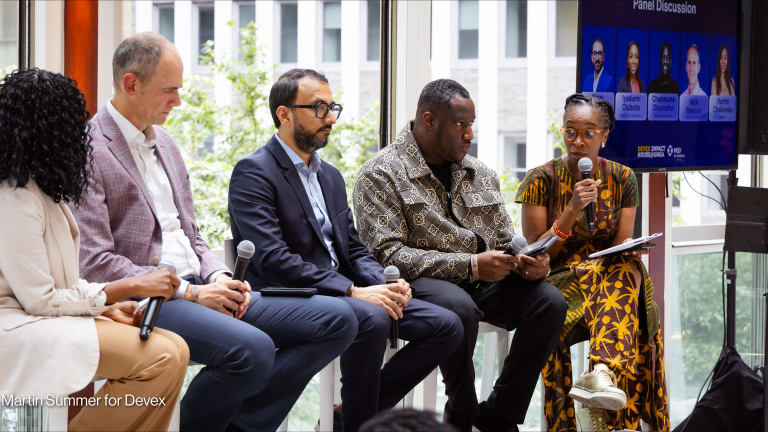
Over the years, blended finance has grown as a means of investing in a multitude of development areas, increasing access to resources for various initiatives, and removing some of the risks that might previously discourage funders from investing. One area in which blended finance hasn’t been utilized to the same extent, however, is health care, say experts.
“We know development assistance to health care is declining and has declined over the last three years … We need to find innovative ways to address this shortfall. We need to bring private sector financing into the equation,” said Lisa Felton, managing director of the Vodafone Foundation during a conversation titled Blended finance in health care: Unlocking new frontiers — a United Nations General Assembly side event hosted by MSD for Mothers, Vodafone Foundation, and Devex in New York.
Blended finance, according to Convergence, a global network for blended finance, is “a structuring approach that allows organizations with different objectives to invest alongside each other while achieving their own objectives.” Both development and private donors invest in a time-bound initiative with a specific aim in mind. The hope is that it will be catalytic and act as a model for replication and future increased commercial funding for development.
Of the blended finance deals that exist, very few are focused on health, said Joan M. Larrea, CEO of Convergence, and even fewer are targeting low- or middle-income countries. Convergence’s data, she said, show that of 1,200 blended finance deals, only 80 relate to health.
Yet health systems around the world are in dire need of resources. The COVID-19 pandemic has decimated what in many places were already subpar health services, as well as existing health care budgets. By 2030, there will be a yearly funding deficit of $176 billion in health care budgets for the world’s 54 lowest-income countries, according to the World Bank.
Attendees at the side event discussed how these can be created and embraced. Over two hours, 65 individuals from impact funds, multilateral development banks, development finance institutions, philanthropic organizations, commercial entities, and intermediaries broke into groups to discuss the barriers to blended finance, opportunities for its implementation in global health, and how to drive progress forward. These are the takeaways.
1. There are many deterrents to blended finance
In general, the health sector is not having enough conversations about financing, said one attendee who was part of the roundtable discussions. There may be one-off conversations, but there is no ecosystem approach in which donors, especially private donors, can collaboratively and easily invest in health care.
A second barrier is the risk level for potential investors who are being asked to invest alongside organizations and governments they may not know or may not have previously built a level of trust with. There’s financial, operational, and political risk, said one attendee, while impact measurement in the health space can also be hard to agree on and difficult to collect, thus leaving many investors uneasy about the level of impact they can have and convey.
With that in mind, the sector needs to come up with a variety of low-risk, high-impact health opportunities that make investment in the sector appealing to donors, suggested attendees. “You need to test, you need to bring a coalition together within the government, and then you need to make the case to the folks who actually hold the purse strings that this is something that's going to actually lead to real results,” said John Simon, managing partner at Total Impact Capital.
While the private sector may still need some proof of concept, Luc Laviolette, head of secretariat at the Global Financing Facility, said that over the years, and partly due to the COVID-19 pandemic, he has seen more willingness from governments to work with the private sector in new financing models. “I think there was a recognition of the weaknesses of the health systems. It became very visible, but also of the role of the private sector because the private sector jumped in and was able to support,” he explained.

2. Some successful models can be replicated
While blended finance examples are light in the health space, there are successful ones that can be used to showcase the impact of such a funding model. The largest impact bond in the world in terms of beneficiaries, for example, focused on health. That is the Utkrisht impact bond, which was launched in 2017 to improve maternal and child health in health care facilities in Rajasthan, India, thus reducing preventable maternal deaths in the demographic. The U.S. Agency for International Development, MSD for Mothers, the UBS Optimus Foundation, Population Services International, the Palladium Group, and the Hindustan Latex Family Planning Promotion Trust pooled funding and split the risk in a bid to reach 600,000 pregnant women and newborns with higher quality care over five years.
An additional example showcased at the event is m-mama, which is a national emergency service providing transport for mothers and newborns to get lifesaving care in hospitals in Tanzania and Lesotho. It launched in 2013 in Tanzania, with Vodafone Foundation and USAID covering the initial setup costs and the government then taking over, with funding underwritten by the World Bank.
“Vodafone Foundation and donor partners fund the one-time setup costs of m-mama, with the government committing to the ongoing costs from day one. This creates a genuine partnership to create a service owned and operated by the government,” Felton told the room.
Over 100,000 mothers and newborns have been transported to emergency care and the service is estimated to have saved over 4,000 lives. “In some regions, maternal mortality reduced by more than 38% and newborn mortality by more than 40%,” she said. The aim is to scale the service to more countries across Africa.
One of the breakout groups talked about the value of creating a platform to exchange learnings on successful blended finance models, and to connect interested partners. “Can we start to do tangible proofs of concepts that are done with localized solutions?” one attendee asked.
3. There are ways of attracting private sector investment to blended finance models
Blended finance models help to provide a blueprint, but more needs to be done to bring the private sector to the table as a critical partner in potential blended finance models, said Pompy Sridhar, India director at MSD for Mothers. “We know that the private sector plays a very important role in a health system. However, there's lots that needs to be done in terms of just supporting the private sector to be successfully integrated,” she said.
For GFF’s Laviolette, that starts with “seeing what bottlenecks exist for the private sector and seeing how we might incentivize that participation.”
One idea might be highlighting the global push, as part of the Sustainable Development Goals, toward universal health coverage. This encompasses health insurance schemes that offer an incentive for the private sector but are still part of a blended finance model. “That could be an important revenue stream for the private sector,” Laviolette said. “They're pooling tax money, sometimes government or other sources of revenue, and then sometimes donor funding into that same pool, but with the private sector participation.”
A second idea is to address the risk of the investment. “Set expectations so that people taking on that risk know what they're getting into, and that all of the risk does not fall on one actor or one partner,” one attendee advised. Additionally, digitizing transfers “helps make them more transparent and more sustainable,” they added.
In a feedback to the collective following a group breakout, Total Impact Capital’s Simon said his breakout group had discussed creating a model where funders can come in at different times, which may also help to address the perceived risk. If a donor can see a model is working before they invest, it might increase the likelihood of their involvement.
4. Blended finance isn’t going to be a solution to everything
While it has the power to bring more resources into the space, many participants were quick to highlight that this one form of finance isn’t going to solve the health sector’s problems in isolation.
It’s important to remember that “outcomes-based financing, social and development impact bonds, and outcomes funds are just one tool in the toolbox,” said Emily Gustafsson-Wright, senior fellow of the Global Economy and Development program at the Brookings Institution. There are many other streams of financing available that still need to be channeled into the health space to yield progress.
“Not everything should be blended finance. It needs a revenue line. It needs a source of income that somebody can imagine, or the private sector doesn't invest,” agreed Convergence’s Larrea.
But in the meantime, attendees were unanimous in their thinking that while not a catch-all solution, more blended finance models would certainly go a long way in saving lives.








